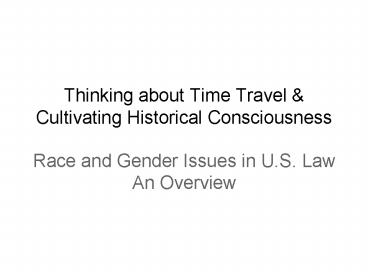Thinking about Time Travel - PowerPoint PPT Presentation
1 / 17
Title:
Thinking about Time Travel
Description:
Her defense rested on a Missouri statue that protected 'any woman' ... Celia was found guilty of murder in the first degree and hanged. 1854. People v. Hall ... – PowerPoint PPT presentation
Number of Views:75
Avg rating:3.0/5.0
Title: Thinking about Time Travel
1
Thinking about Time Travel Cultivating
Historical Consciousness
- Race and Gender Issues in U.S. Law An Overview
2
Indian Removal Act of 1830
- President Andrew Jackson refused to enforce the
decisions of the U.S. Supreme Court upholding
Cherokee tribal autonomy. - Cherokees were forcibly removed from Georgia and
their land appropriated by white settlers. - Other eastern tribes met a similar fate under the
Indian Removal Act of 1830.
3
1831
- An Act to Prevent All Persons from Teaching
Slaves to Read or Write - From Acts Passed by the General Assembly of the
State of North Carolina at the Session of
1830-1831 - If a white man or woman, to be fined not less
than 100, nor more than 200, or imprisoned - If a free person of color, to be fined,
imprisoned, or whipped, not exceeding thirty-nine
lashes, nor less than twenty lashes.
4
1846-1848
- Mexican-American War
- Grew out of U.S. expansionist policy, Manifest
Destiny - Mexico lost half of its territory in the war, and
territories annexed by the U.S. contained
thousands of Mexican families
5
1848
- The First U.S. Womens Rights Convention held at
Seneca Falls, N.Y. - Participants listed womens grievances and
specified demands. - At the time, married women were regarded as
property of their husbands and had no direct
legal control over their own wages, their
property, or even their children. - Frederick Douglass spoke at the convention.
6
1851 Sojourner Truth (1779-1883) Declares Aint
I a woman? in 1851 at a Womens Rights
Conference in Akron, Ohio. Truths challenge to
patriarchy and to white feminists vested
interests in whiteness. Feminist Claims For
whom? Where? When?
7
1855
- State of Missouri v. Celia
- Pregnant and ill, after her master had repeatedly
forced her into sexual intercourse, Celia
defended herself one day and hit Robert Newsome
over the head with a stick, killing him. - Her defense rested on a Missouri statue that
protected any woman from attempts to ravish,
rape, or defile. - Celia was found guilty of murder in the first
degree and hanged.
8
1854
- People v. Hall
- The California Supreme Court decided that a
statute barring Indians and Negroes from
testifying in court cases involving whites also
applied to Chinese Americans. - The judges asserted that the Chinese are a race
of people whom nature has marked as inferior, and
who are incapable of progress or intellectual
development beyond a certain point.
9
1865
- The Thirteenth Amendment is passed
- After the end of the Civil War, all people held
as slaves were freed. - However, the Southern States began to pass laws
known as the Black Codes to limit the economic
and physical freedom of the formerly enslaved. - During Congressional Reconstruction (1866-1876),
the federal government declared these acts of
legal discrimination illegal.
10
1873
- Bradwell v. Illinois
- The U.S. Supreme Court ruled that women could not
practice law and used the opportunity to
carefully distinguish the rights and prerogatives
of men from those of women. - The court maintained that civil law, as well as
nature herself, has always recognized a wide
difference in the respective spheres and
destinies of man and woman.
11
1877
- The federal government essentially abandons all
efforts at protecting the civil rights of
southern blacks. - Southern states moved to legally impose
segregation through Jim Crow laws. - Jim Crow train car anti-miscegenation laws
voting restrictions (poll taxes)
12
1887
- General Allotment Act
- Divided tribal landholdings among individual
Indians and thereby undermined the tribal system
and culture it was a part of.
13
1896
- Plessy v. Ferguson
- The Supreme Court rules on whether segregation by
race in public facilities violated the Thirteenth
and Fourteen Amendments and decides that
restricting Negroes to separate but equal
public accommodations did not deny them equal
protection of the law.
14
1898
- Spanish-American War
- New age of American expansionism
- The U.S. gains control over former colonies of
Spain in the Caribbean and Pacific Puerto Rico,
the Philippines, and Guam. - Also the year in which the annexation of Hawaii
represents the culmination of more than 50 years
of U.S. commercial interests in the islands.
15
1920
- Nineteenth Amendment passed.
- Women win the right to vote a citizens right to
vote "shall not be denied or abridged by the U.S.
or by any State on account of sex."
16
1944
- Korematsu v. United States
- The military evacuation of Japanese Americans to
internment camps is challenged. - The Supreme Court upheld the forced evacuation.
17
1954
- Brown v. Board of Education of Topeka
- The Supreme Court rules, in effect, that
separate could not possibly be equal. - Integration of public schools, housing, and
employment continues today.































